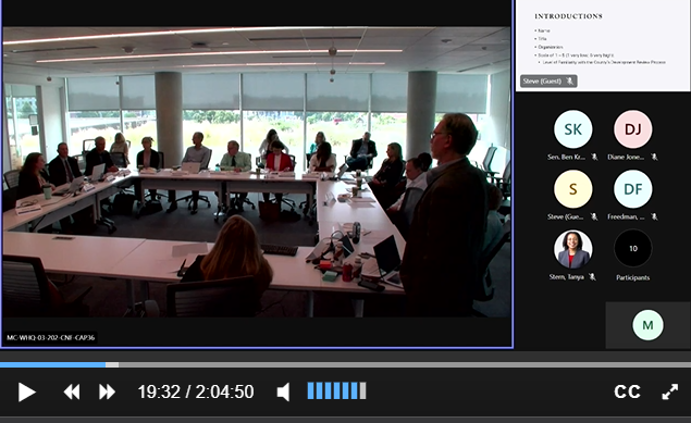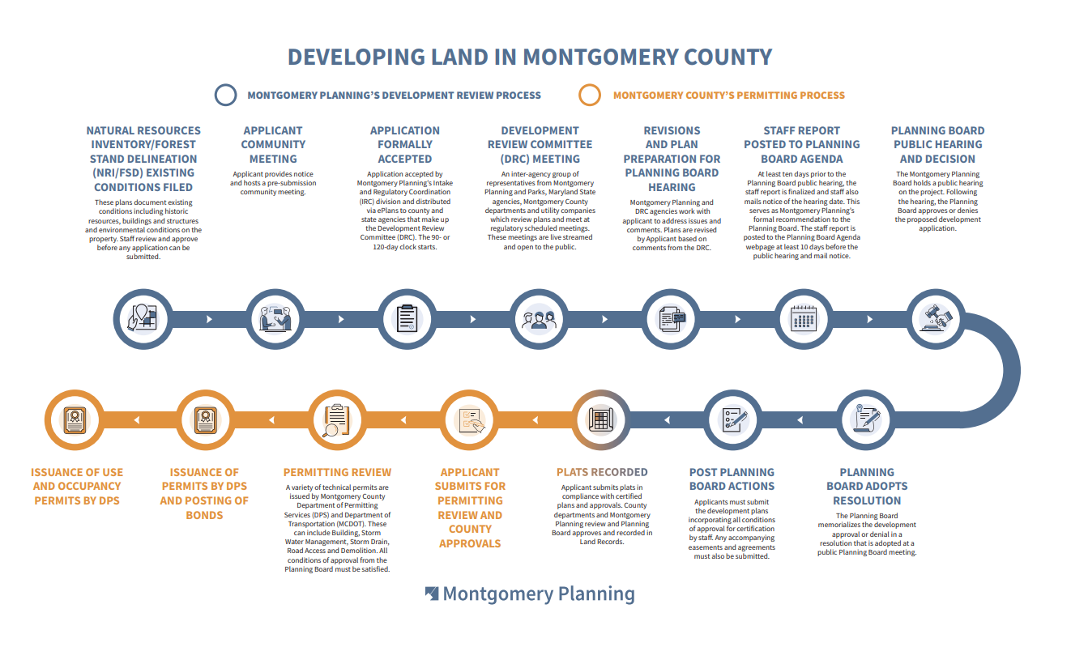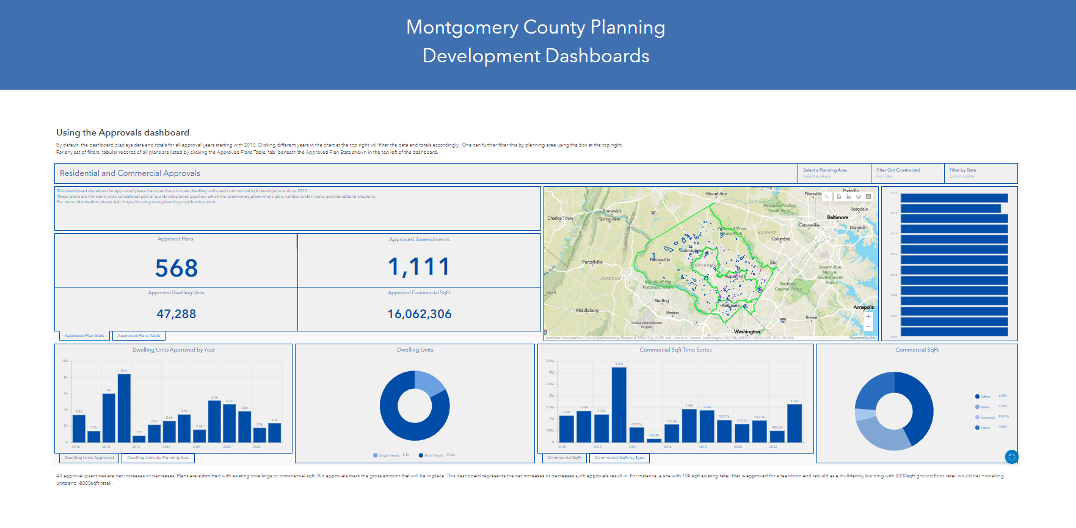By Robert Kronenberg, Montgomery Planning Deputy Director
A central focus of Montgomery Planning’s work plan for 2024 is housing. Like many places across the country, Montgomery County’s housing shortage has meant rising rents and housing prices. We’re committed to collaborating with our county and state government partners, the development community, and residents to find ways to expand our housing supply and make the county a more affordable place for everyone to live. A major part of making that happen is streamlining the review and approval process for new development in the county to become a reality quicker.
Last year, under the leadership of Maryland Delegate Lesley Lopez (District 39), representatives from Montgomery Planning, Montgomery Parks, Montgomery County government, developers, and the community formed a workgroup to identify challenges and develop solutions to speed up the review and approval process without cutting corners to get projects off paper and into the ground. After a five-month public process, the workgroup agreed on 22 recommendations contained in a report sent to the General Assembly. Some recommendations require action by only Montgomery Planning or the Planning Board, while others rest with our fellow process stakeholders. I am pleased to share we are already making meaningful progress on several of the recommendations.

Screenshot from the streamcast of the first Development Review Process Workgroup meeting held in Summer 2023. The members of the workgroup included key stakeholders from the development and broader community, Montgomery Planning, County Council and County Executive Branch agencies.
First, a few resources I wanted to share.
During this effort, we provided community members and other stakeholders a step-by-step timeline of how land is developed in Montgomery County. The Developing Land in Montgomery County infographic shows the development review process from the moment an application is filed until the Montgomery County Department of Permitting Services issues building permits. This graphic is available in Español and on our website.

Another resource is Montgomery Planning’s Development Review Dashboard tool, launched in time to help the members of the Development Review Process Workgroup understand real-time data as they considered recommendations. You can filter data for residential units and commercial square footage approvals since 2010 and see review times for all plan types since 2018. I encourage community members to explore this tool to learn more about development stats in Montgomery County.

Below are updates on recommendations already underway:
Recommendations 1, 2 & 3: Changes to state law (in progress)
It became clear during the workgroup’s discussions that significant time is lost in processing paperwork for applications. This includes the requirement for real signatures on documents from multiple stakeholders. To improve and expedite this process, the workgroup proposed two changes to state law that would allow for conditional plat approval while signatures are pending, digital signatures on plats, and archiving of digital plats.
These enhancements are included in HB 1309 Transportation – State Highways – Project Approval, HB 989 Montgomery County – Subdivision Plats – Conditions and HB 1003 Montgomery County – Clerk of Court – Subdivision Plat Recordation Act. We thank Delegate Lopez for advancing these bills on behalf of the workgroup.
Recommendation 5: Create an opt-in email list for notice of all projects. (complete)
Knowledge is power, and Montgomery Planning believes deeply in empowering community members and stakeholders with the information they need to engage in the planning process. Aligned with this belief, we have launched the Development Review e-letter to ensure stakeholders and community members know when a developer provides notice that it is submitting a development application and will host a community meeting about the project. Sign up for the development review e-letter. This e-letter will be in addition to the existing to the Parks + Plans weekly eletter, which also provides the community with information about programs and projects from Planning and Parks.
Recommendation 6: Update the sign at the site of pending developments for clarity and include a QR code linked to the project for ease of access. (in progress)
With more than 90% of Americans owning a smartphone, and QR codes growing in popularity as a result of the COVID-19 pandemic, updating development signage to include a QR Code will help residents quickly and easily get access to information about pending developments. Our team has already begun to create designs in response to this recommendation and plan to roll out the new signage in the next month!
Recommendation 7: Evaluate the intake process to reduce the amount of time from the receipt of the initial application to the date of acceptance of the application by reducing the number of repeat submittals. (in progress)
Montgomery Planning is analyzing staffing needs and other internal assignments to improve the development application intake process to reduce the amount of time from the receipt of the initial application to the date of acceptance of the application. Montgomery Planning has developed a new checklist for applicants to make the intake requirements clearer and easy to follow. This change and others will continue to improve upon the efficiency of the intake process.
Recommendation 8: Provide training on intake for applicants and their consultants that is recorded and uploaded to the Planning Department website for future reference. (in progress)
Montgomery Planning will host a training seminar for consultants and applicants on the intake process in the Spring of 2024. That training will be recorded and uploaded to Montgomery Planning’s website and available on-demand for future use.
Recommendation 14: Update the Lead Agency Memorandum of Understanding (MOU) during fiscal year 2024 to address clarity on decisions and responsibilities/authority of MOU signatories – particularly for DPS, MCDOT, and Planning Board – related to improvements in the Right of Way, access and loading, traffic, safety, on-site development issues, and conflict resolution, consistent with state and county law. All signatories will also engage in an updating process to correct agency and other archaic references in the current Lead Agency MOU. Ensure that any related documents impacted by the update are also in agreement. (in progress)
In March, the county’s Development Review Committee will begin discussing clarifications and updates to the Lead Agency Memorandum of Understanding (MOU) that outlines the decision-making responsibilities of government agencies and the Planning Board related to improvements in the Right of Way, access and loading, traffic, safety, on-site development issues, and conflict resolution.
Recommendation 15: Evaluate the potential for a more streamlined review of administrative review processes. (in progress)
Montgomery Planning staff is continuously evaluating the development review process to find ways to streamline the review of certain applications. As part of this evaluation, Montgomery Planning will look at the Administrative Procedures for Development Review, the Subdivision Regulations, and the Zoning Ordinance to recommend improvements to the County Council. Staff will prepare recommendations and present them to the Planning Board and then the County Council will have final approval.
Recommendation 17: Require an Applicant’s affidavit from the pre-submission meeting be attached to the Staff Report. It should include a summary of concerns raised by the community at the pre-submittal meeting and the applicant’s response to those concerns (issue addressed, change made, ‘can’t be done under current law’, etc.). The staff report should also include a specific section on community concerns that have been raised and how these concerns were addressed by the applicant. (complete)
Prior to review of a development project application, Montgomery Planning requires project applicants provide a summary of concerns raised at any required community meeting that they host before submitting a project application. The summary must also include the applicant’s response to those concerns. Community concerns have been a part of the staff reports for quite some time but now the reports include the summaries from the community meeting.
Recommendation 18: Require Applicants to provide an overview of opportunities for public comment and participation during the application review process at the pre-submittal meeting. (in progress)
This is an ongoing exercise for development applicants to provide information at the community meetings. We will be providing more information and support, including weblinks, flowcharts and contact information in our update to the Administrative Procedures.
Recommendation 22: Require clear response and communication with stakeholders whose comments were not reviewed by the workgroup due to insufficient time. Ensure that all comments submitted to the workgroup are included as an attachment to the main body of the report and that a county agency or the Planning Department is identified as the responsible party to respond. (in progress)
Montgomery Planning and Montgomery County agencies have begun responding to comments by the community or other stakeholders unable to be reviewed by the Development Review Process Workgroup due to insufficient time.
We will continue providing regular updates on progress toward implementing these recommendations. We encourage the community to visit our website to learn more about how the county’s development review process works.
 About the author
About the authorRobert Kronenberg is the Deputy Planning Director for Montgomery Planning and oversees the Downcounty, Midcounty and Upcounty planning teams as well as the Intake and Regulatory Coordination Division (IRC). His background is in landscape architecture and planning with over 20 years of service at the Maryland National-Capital Park and Planning Commission in a number of capacities, including enforcement, development review and master plans. He has led a wide range of projects and plans that have improved the quality of life and experience in the natural and built environments, including Cabin Branch, Clarksburg Town Center, Marriott Headquarters, Park Potomac, and Downtown Silver Spring.